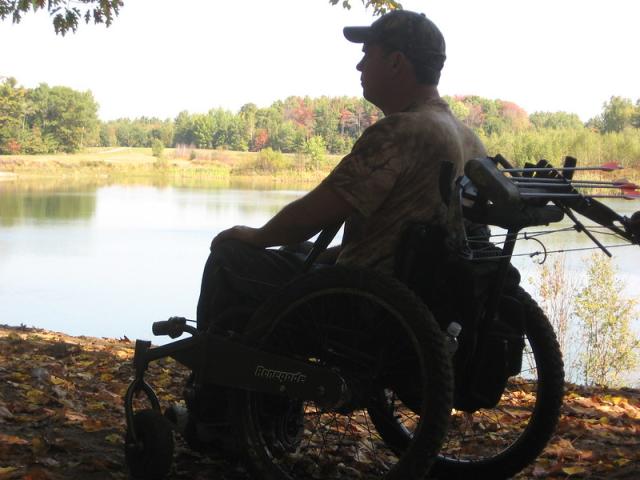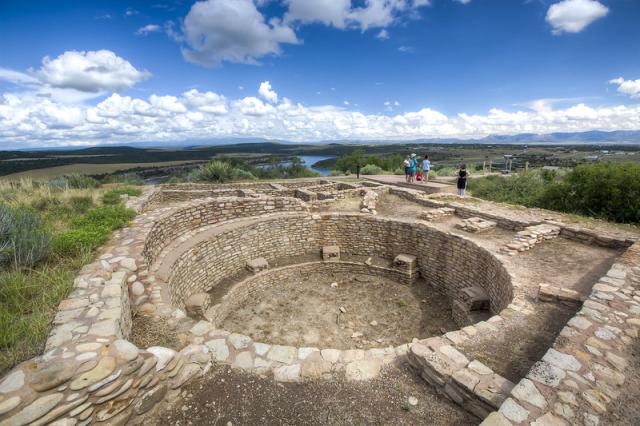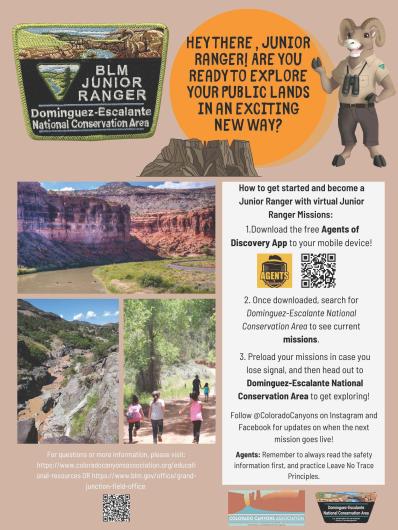BLM Recreation Sites Available to All: Exploring Accessibility on Colorado’s Public Lands
The EXPLORE Act, or the Expanding Public Lands Outdoor Recreation Experiences Act, is designed to improve access to outdoor spaces for people with disabilities, veterans, and children, among others. In support of that law, over the next year we will explore accessible public lands, state-by-state, managed by the Bureau of Land Management (BLM) on behalf of the American people.
Colorado manages about 8.3 million acres of public lands for the use and enjoyment of present and future generations. The BLM Colorado Outdoor Recreation Program staff has been working together to ensure all people can enjoy these lands.
This month, we’ll explore some of the sites and recreation opportunities available to all on Colorado’s public lands, including hunting and fishing for people with very limited mobility, learning about ancient peoples who lived in Colorado, finding quiet and solitude on either side of the Continental Divide, solving Junior Ranger missions, and anticipating new opportunities.
The BLM often partners with local agencies and organizations to accommodate individuals with disabilities, increasing their opportunities to access outdoor recreation.
Hunting and Fishing
Colorado is known for its plentiful and diverse outdoor recreation, including hunting and fishing. The BLM manages public lands and its habitats, while the state, through Colorado Parks and Wildlife, manages hunting and fishing permits and licenses. The BLM also manages outfitters and guides through special recreation permitting on public lands. These guides can facilitate hunting, fishing, and other recreation opportunities for people of all ages and abilities.
It’s common knowledge that before hunting or fishing on public lands, you need to get a license. Individuals with disabilities may also need accommodations to be able to hunt or fish. Colorado Parks and Wildlife can help with both.
Whether you need a different type of scope, or the ability to shoot from a vehicle, or some other type of accommodation, Jeremy Sifuentes, Colorado Parks and Wildlife ADA coordinator, can help those who qualify to get an Accommodation Permit.
“I love being able to help people get back to hunting and fishing again. Maybe they became disabled 10 or 15 years ago and didn’t realize there are accommodations and programs available now that can support their ability to do what they love again,” said Sifuentes. “It’s the best feeling!”
He also mentioned that a Colorado resident with a total or permanent disability can apply for a free lifetime fishing license.

One accommodation a person might need is the use of an adaptive device. Adaptive equipment and devices range from simple tools, like crutches, to complex technologies, like robotic prosthetics. The devices can help individuals with disabilities perform daily activities, increase their independence, and improve their quality of life.
The all-volunteer Outdoor Buddies is one of the organizations in Colorado with adaptive equipment that can enable people with disabilities to participate in activities they never thought possible—like hunting or fishing. They have all-terrain wheelchairs, adaptive fishing poles, and sip-and-puff mechanism shooting mounts for people with no hand or arm movement, among other equipment.
Larry Sanford, president of Outdoor Buddies, talked about a member who had never shot a gun in his life but wanted to try target shooting. “He had so much fun using the adaptive equipment for target shooting, now he’s planning a hunting trip. He said if he had never gotten hurt, he wouldn’t have imagined himself [doing this],” said Sanford.
The National Sports Center for the Disabled is another organization that helps people with disabilities redefine how they approach life, by focusing on their abilities and showing them what they can accomplish in an outdoor recreation setting. By redefining adaptive outdoor experiences, such as mountain biking or river rafting, and re-inventing adaptive equipment, people with disabilities can have adventures on public lands they never thought possible.
Learning About Ancient Peoples
Canyons of the Ancients National Monument, in the Four Corners region of southwest Colorado, has the highest known archaeological site density in the United States. Visitors can begin at the Visitor Center and Museum to learn about the site and ask the knowledgeable staff about places to go, weather conditions, and available maps and brochures. The low front desk, plentiful exhibits, and large auditorium can accommodate people in wheelchairs or other mobility devices.
Many visitors like to learn about a site before they go. A seven-minute video, Discover For Yourself: Canyons of the Ancients National Monument, provides a nice overview of the Monument, while comparing it to more developed sites in the area.
If you prefer brochures and booklets, the Canyons of the Ancients National Monument brochure has a map, safety tips, and discussion of ancient indigenous settlements in the area called pueblos. The Junior Explorer: Archaeology booklet provides a fun, interactive way for youth or individuals with intellectual and developmental disabilities to learn about the area before they visit. The Canyons of the Ancients National Monument: A Living Landscape booklet explores cultural history and the sacred connections the Apache, Navajo, Ute, and Pueblo tribes have with this land.
A half-mile accessible – although moderately steep – trail leads from the Visitor Center to the Escalante Pueblo. From there, you can see the smaller Dominguez Pueblo. Both are described in the Escalante & Dominguez Pueblos brochure. About 25 miles northwest, a quarter-mile accessible trail leads to another large pueblo and Great Kiva – a place used for spiritual ceremonies and worship – at the Lowry Pueblo National Historic Landmark. Although the trail is accessible, there are some steps to the Kiva inside the Pueblo, posing a challenge for some visitors with limited mobility.


Solitude in Dark Sky Parks
If quiet and solitude are what your soul is craving, Colorado has two International Dark Sky Parks. Gunnison Gorge National Conservation Area was certified as a Dark Sky Park in August 2024 and Browns Canyon National Monument in December 2024.

Three hours apart on either side of the Continental Divide, both are south of Interstate 70 and west of Interstate 25, and described as “remote and rugged.” Each of the areas has rivers that are designated as a Gold Medal Trout Fishery and a wilderness or wilderness study area within their boundaries.
While there are several options to participate in recreation activities surrounded by other enthusiastic lovers of public lands, there are also plenty of places to sit in peace, surrounded by breathtaking vistas by day and skies by night. The silence can quiet the mind and calm the body. Focusing on distant peaks gives eyes a break from staring at a television, computer, or phone screen. Inhaling the scent of a fresh rain or nearby vegetation can reduce stress levels and foster a sense of belonging and connection to the environment.
The Gunnison Gorge NCA brochure and the Browns Canyon NM brochure can help you plan your visit.

Agents of Discovery Missions
Children and people with intellectual or developmental disabilities have the opportunity to complete up to five Junior Ranger Missions in Colorado using the Agents of Discovery app. The app was developed to connect youth with the natural world. It accommodates different learning styles and can be used in six languages.
Explore the Lowry Pueblo, complete challenges up the Sand Canyon Trail, or discover new and exciting facts about the Dominguez and Escalante Pueblos, all within the Canyons of the Ancients National Monument.
Or if you’re at the Dominguez-Escalante National Conservation Area (NCA), south of Grand Junction, the missions include discovering the NCA or Escalante Canyon itself. You can read about the area in the Dominguez-Escalante NCA brochure.


What to Watch For
Improving and expanding trails is one of the goals of the EXPLORE Act. BLM Colorado is improving accessibility to land and water trails. For example, the Uncompahgre Field Office is working with a local mountain bike committee to build an adaptive bike trail for adaptive cycle use at the popular Ridgway Area Trails. Near the town of Ridgway, this extensive trail system has multi-use trails on state (Ridgway State Park) and federal (BLM) lands. The field office is also coordinating with an outfitter who is filming the Gunnison River so future visitors can take a virtual tour.

With completion of the Blue Valley Land Exchange (Grand and Summit counties), the Northwest District Office plans to make improvements to the site, including accessible fishing platforms, trails, restrooms, and parking areas.

Tim Finger, recreation program manager in Colorado, explained: “We have improved the accessibility of many of our developed recreation sites in the state. Most of our sites have some accessibility features. Our plan is to upgrade at least one site per year.”
These are just a few of the amazing areas and activities the BLM manages in Colorado on behalf of the American people. The BLM is dedicated to ensuring that everyone has an equitable opportunity to use their public lands by providing access to facilities, programs, services, and activities for people with disabilities. The BLM Accessibility Program provides details on opportunities, resources, laws, policies, and guidelines.
Useful Links
- EXPLORE Act – to improve recreation opportunities on, and facilitate greater access to, federal public lands.
- Access Pass – free lifetime pass for U.S. citizens or permanent residents with permanent disabilities.
- Military Lifetime Pass – free pass for Gold Star families and veterans.
- Every Kid Outdoors – free pass for fourth graders and their families.
Cathy Humphrey, Experienced Services Program
Related Stories
Office
PO Box 151029
Denver Federal Center- Building 40
Lakewood, CO 80215
United States
